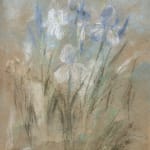John Henry Twachtman 1853-1902
43.8 x 34.3 cm
Framed dimensions: 22 1/2 x 18 in
As one of the leading Impressionist painters of the late 19th century, John Henry Twachtman was at the forefront of a rising generation of American artists who sought to find innovative modes of capturing the modern American scene. The grandiose landscapes of the Hudson River School had become outdated, and contemporary American artists such as Twachtman once again found themselves turning to Europe in search of new forms of expression.
John Henry Twachtman was born in Cincinnati, Ohio in 1853. After studying briefly at the Ohio Mechanics Institute and the McMicken School of Design, Twachtman fell under the influence of Frank Duveneck, an artist of the Munich school. In 1875, he travelled to Europe and studied at the Royal Academy in Munich, where he adopted the dark, painterly realism typical of that institution. During the next few years, Twachtman travelled throughout Europe in the company of artists such as William Merritt Chase and J. Alden Weir. By 1883, Twachtman found himself in Paris, where his style underwent a profound change as he began to be influenced by the Tonalism of Whistler and the French Impressionists. In 1889, Twachtman bought a home and property in Greenwich, Connecticut, and this area became his principal subject throughout the 1890s. During this period, his paintings began to lighten, and they continued to become brighter and more impressionistic as his style matured. In Greenwich, his work became both “strongly evocative of real experiences of nature and quietly poetic” (John Henry Twachtman: An American Impressionist 13).
When Twachtman relocated to Greenwich in 1889, he was right on time for America’s turn at a renaissance of pastels initiated by French Impressionists. Twachtman was influenced in particular by Whistler’s technique of making use of paper as a part of the picture’s design, laying down gentle caresses of pastel so as to allow his pumice and oatmeal grained papers to shine. Also inspirational to Twachtman was the garden of his new Connecticut home. Fascinated by the free, wild side of nature, Twachtman allowed his garden to grow largely unchecked with varieties of flowers such as phlox which flourish without careful cultivation. This style of wild garden was popular in the late 19th century, but although Twachtman was following a trend in that regard, he was simultaneously resisting the habits of fellow artist-gardeners such as Monet who fashioned their gardens in the image of their artwork. Twachtman, conversely, fashioned his art in the image of his garden.
Twachtman’s floral pastels, his favored subject for the medium, were described both as “ghosts” and as “dreams.” Indeed, his delicate pastels convey the “fragile essence” of flowers and their susceptibility to the slightest changes in atmosphere and light (John Henry Twachtman: An American Impressionist, 83). Twachtman unconventionally chose to depict his florals as untied to a garden plot and free from the constraints of a vase; his “dreams of flowers” dance and sway unbound, growing as in nature. Additionally, Twachtman’s focus did not lie with detailed botanical accuracy or vibrancy of color. Instead, Twachtman “[delighted] in the movement of flowers” (In the Sunlight: The Floral and Figurative Art of J.H.Twachtman 92).
Irises, c. 1890s, is one such ode to the motion of flowers. The application of the pastel has a freeness to it, a sketchiness more prominent than in Irises’ floral counterparts. The final product is evident of Twachtman’s “direct response to light, color, and form in the landscape” and these qualities’ manipulation of the irises themselves (In the Sunlight: The Floral and Figurative Art of J.H.Twachtman 92). According to Lisa N. Peters, "Twachtman used pastel with gestural spontaneity in Irises, depicting the blossoms and stems of a cluster of the perennial multi-lobed flowers from a low vantage point. His close-up view of the flowers, along with a sense of their daytime growth, is suggestive of the images of the complex flower by Van Gogh such as Irises, 1889 (J. Paul Getty Museum, Los Angeles)." (jhtwachtman.org) Additionally, the pale blue and white flowers are certainly dreamlike; the colors seem fragile enough to blow away in a breeze. These flowers, the irises, are undoubtedly captured not by a scientific eye, but by an artist’s, a master of pastels.
Provenance
Milch Galleries, New York;Mr. and Mrs. Franklin Biggs, Middleton, Delaware (by 1983);
Coe Kerr Gallery, New York;
Ira and Nancy Koger (acquired from the above, 1984);
Private collection, 1992 until 2024;
Christie's, New York, Impressionist and Modern Works on Paper Sale, May 18, 2024, lot 544.
Exhibitions
Winter Park, Florida, Rollins College, George D. and Harriet W. Cornell Fine Arts Center, The Genteel Tradition: Impressionist and Realist Art from the Ira and Nancy Koger Collection in Celebration of the Centennial of Rollins College, November 1985-January 1986, pp. 84-85 and 93 (illustrated).New York, Spanierman Gallery, In the Sunlight: The Floral and Figurative Art of J.H. Twachtman, May-June 1989, pp. 22, 92 and 93 (illustrated, pl. 19).
Literature
This work is included as number P.912 in the John Henry Twachtman Catalogue Raisonné (jhtwachtman.org/) by Dr. Lisa N. Peters in collaboration with the Greenwich Historical Society.Please join our mailing list
* denotes required fields
We will process the personal data you have supplied in accordance with our privacy policy (available on request). You can unsubscribe or change your preferences at any time by clicking the link in our emails.



